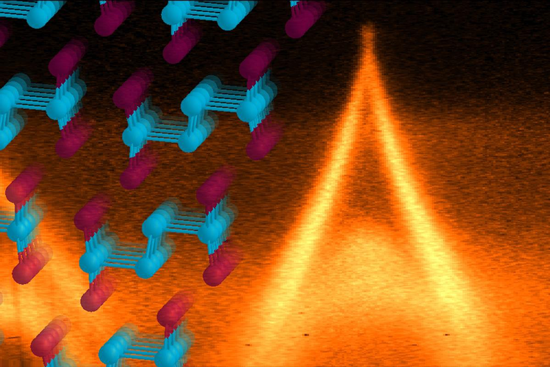Topological insulators (TIs) are materials with many exotic properties. Perhaps the most technologically salient is the suppression of electron scattering on their surfaces—a tantalizing path to energy-saving, ultralow-power electronics. This prospect has led to a vigorous search for optimal TIs, most of which have so far been layered, quasi-2D materials. Now, an international team of scientists has discovered the first of a new class of TIs: quasi-1D bismuth iodide.
Bismuth iodide is composed of weakly interacting, stacked “1D” chains, four bismuth atoms wide, with iodine atoms along the edges. These 1D molecular building blocks can be stacked in two ways, designated the “α” and “β” phases. The research team predicted that the β phase would be a strong TI. They then synthesized the material, verified its crystal structure, and used angle-resolved photoemission spectroscopy (ARPES) at ALS Beamline 4.0.3 to confirm its TI nature.
The highly ordered structure of bismuth iodide has several advantages. It gives rise to fewer natural defects and can be cleanly cleaved, creating atomically flat surfaces. Surface electrons traveling in the direction of the chains move five times faster than perpendicular to them. Intriguingly, we might be able to tune its TI properties by applying external pressure or adjusting its chemical composition. Because of its novel structure, quasi-1D bismuth iodide provides great opportunities for advances in both practical applications and fundamental science with relatively simple chemistry.

ARPES measurements were performed at ALS Beamline 4.0.3. Overall work was performed within the framework of the EPFL-led NCCR Marvel project.
G. Autès, A. Isaeva, L. Moreschini, J.C. Johannsen, A. Pisoni, R. Mori, W. Zhang, T.G. Filatova, A.N. Kuznetsov, L. Forró, W. Van den Broek, Y. Kim, K.S. Kim, A. Lanzara, J.D. Denlinger, E. Rotenberg, A. Bostwick, M. Grioni, and O.V. Yazyev, “A novel quasi-one-dimensional topological insulator in bismuth iodide β-Bi4I4,” Nature Materials 15, 154 (2016).